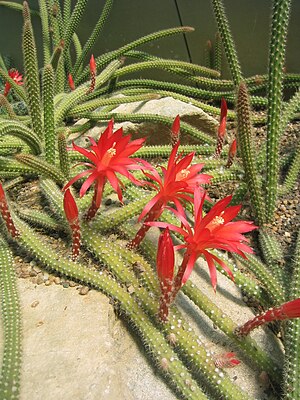Aporocactus martianus
Aporocactus martianus ist eine Pflanzenart aus der Gattung Aporocactus in der Familie der Kakteengewächse (Cactaceae). Das Artepitheton martianus ehrt den deutschen Botaniker Carl Friedrich Philipp von Martius.[1]
| Aporocactus martianus | ||||||||||||
|---|---|---|---|---|---|---|---|---|---|---|---|---|

Aporocactus martianus | ||||||||||||
| Systematik | ||||||||||||
| ||||||||||||
| Wissenschaftlicher Name | ||||||||||||
| Aporocactus martianus | ||||||||||||
| (Zucc.) Britton & Rose |

Beschreibung
BearbeitenAporocactus martianus wächst kriechend, gelegentlich lithophytisch mit Luftwurzeln bildend. Die einzelnen Triebe werden bis zu 1,5 Meter lang und bis zu 2,5 Zentimeter dick. Die 8 bis 10 warzenförmigen Rippen werden von 3 bis 4 braunen Mitteldornen gezäunt. Die 6 bis 10 Randdornen sind hellgelblich und nur 5 bis 7 Millimeter groß. Hell rote Tag-Blüten mit einer Größe von 10 bis 12 Zentimeter im Durchmesser und einer Länge von 5 bis 7 Zentimeter wechseln sich den ganzen Sommer über ab. Die grünen, runden Früchte werden bis zu 2 Zentimeter groß.
Verbreitung, Systematik und Gefährdung
BearbeitenAporocactus martianus ist im mexikanischen Bundesstaat Oaxaca verbreitet.
Die Erstbeschreibung als Cereus martianus erfolgte 1832 durch Joseph Gerhard Zuccarini.[2] Nathaniel Lord Britton und Joseph Nelson Rose stellten die Art 1923 in die Gattung Aporocactus.[3] Weitere nomenklatorische Synonyme sind Eriocereus martianus (Zucc.) Riccob. (1909) und Disocactus martianus (Zucc.) Barthlott (1991)[4].
In der Roten Liste gefährdeter Arten der IUCN wird die Art als „Near Threatened (NT)“, d. h. als gering gefährdet geführt.[5]
Nachweise
BearbeitenLiteratur
Bearbeiten- Edward F. Anderson: The Cactus Family. Timber Press, Portland (Oregon) 2001, ISBN 0-88192-498-9, S. 224.
- Curt Backeberg: Die Cactaceae: Handbuch der Kakteenkunde. 2. Auflage. Band II: Cereoideae : Hylocereeae - Cereeae [Austrocereinae]. Gustav Fischer Verlag, Stuttgart/New York 1983, S. 821.
- Alwin Berger: Kakteen – Anleitung zur Kultur und Kenntnis der wichtigsten eingeführten Arten. Eugen Ulmer, Stuttgart 1929, S. 109.
- Karl Schumann: Gesamtbeschreibung der Kakteen (Monographia cactacearum). J. Neumann, Neudamm 1899, S. 143 (online).
Einzelnachweise
Bearbeiten- ↑ Urs Eggli, Leonard E. Newton: Etymological Dictionary of Succulent Plant Names. Birkhäuser 2004, ISBN 3-540-00489-0, S. 148.
- ↑ Joseph Gerhard Zuccarini: Flora oder Botanische Zeitung. Band 15, Nr. 2, 1832, Beiblatt 66 (online).
- ↑ N. L. Britton, J. N. Rose: The Cactaceae. Descriptions and Illustrations of Plants of the Cactus Family. Band II. The Carnegie Institution of Washington, Washington 1923, S. 220 (online).
- ↑ Nadja Korotkova, Thomas Borsch, Salvador Arias: A phylogenetic framework for the Hylocereeae (Cactaceae) and implications for the circumscription of the genera. In: Phytotaxa. Band 327, Nummer 1, 2017, S. 20 (doi:10.11646/phytotaxa.327.1.1).
- ↑ Disocactus martianus in der Roten Liste gefährdeter Arten der IUCN 2013.2. Eingestellt von: Hernández, H.M., Gómez-Hinostrosa, C. & Cházaro, M., 2009. Abgerufen am 5. Januar 2014.